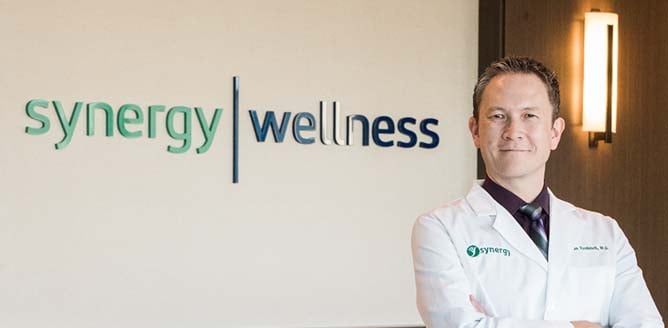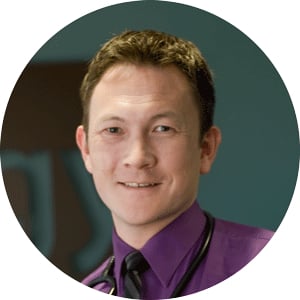
Thinning hair and balding are extremely common among the male population; an estimated 80% of men will experience progressive hair loss. Most men don’t experience the onset of overt hair thinning until their 40s or later, but in others, hair thinning can begin as early as the late teens, which can have devastating consequences on self-esteem, fledgling careers, and social lives. The popular media likes to pretend that men really don’t care about hair loss and just accept it, but many surveys of actual affected men indicate otherwise. Balding men generally say if given the choice they’d rather have a full head of hair than a large sum of money. Until recently, however, there were only a few options for hair restoration for men and all came with serious downsides; but today, we have PRP as an excellent hair restoration option.
Platelet-Rich Plasma
Platelet-rich plasma (PRP) is prepared from the patient’s own blood. A normal venous blood sample is taken from the arm and is then subjected to centrifugation to produce the PRP. Centrifugation spins the blood rapidly and separates its components by size and density. Although there are a number of variations applied to the preparation of PRP, the most common method used for hair restoration for men simply uses two centrifugation steps. The blood is collected into a tube with an anticoagulant in it to prevent premature activation of the platelets. The blood is then centrifuged to remove the red blood cells, which accumulate at the bottom of the tube during centrifugation. The yellowish upper layer is centrifuged again at a higher speed, which causes the platelets to accumulate towards the bottom of the tube; the upper two-thirds is removed, leaving behind PRP. A typical 30 ml blood sample will yield two to three ml of PRP.
What Is the Treatment Like?
Hair restoration for men is really quite straightforward and takes less than an hour; there is no recovery or downtime required after the treatment so men can simply return to work or their regular activities afterwards. A blood sample is taken, and while the PRP is being prepared in another room in the clinic a numbing cream is applied to the scalp. Then, using a tiny needle, the activated PRP is injected into the scalp in multiple locations. There may be some minor redness and irritation for a few hours after each treatment. A typical initial hair restoration procedure requires three PRP sessions at one month intervals. Results usually become apparent shortly after the third treatment as the hair visibly begins to grow and thicken, and this hair regrowth process continues for several months, with final results usually evident around six months after the initial PRP session. Most men need a touch-up PRP session every year to maintain their lush locks. PRP can be used in conjunction with other hair restoration measures, such as minoxidil, but most men are satisfied with the results of PRP alone.
Is It Safe?
Since the PRP is prepared from the man’s own blood, there is no risk of disease transmission or rejection. There is a very low risk of developing an infection at the site of the injections, but if a skilled, trained practitioner uses normal aseptic procedures during the PRP preparation and injection, this risk is basically zero. No other adverse events or side effects have ever been reported in conjunction with these hair restoration treatments for men.
What Are Platelets?
Platelets are formed in the bone marrow as a membrane-contained structure being extruded and then pinching off of their progenitor cells. They are not considered to be cells themselves since they lack many of the normal organelles found in cells and are much smaller than a normal cell. In the bloodstream they usually have a lifespan of around eight or so days unless they are activated to heal a wound before then. Old unused platelets are destroyed in the liver and spleen and replaced by new ones. Platelets contain a rich cocktail of clotting factors, growth factors, and cytokines, and their only purpose is to heal wounds. Originally it was thought they just passively circulated throughout the body until they were activated by a wounding process, but more recent studies have shown they actively seek out injured tissues and have been observed to change shape and actively crawl over tissues in order to reach sites of damage.
When activated by an injury, platelets release their contents into the local area. Each platelet contains at least 30 different proteins with various functions associated with healing. Their most obvious role is to induce blood clotting to stop bleeding, but the proteins they release do so much more. The complex mixture of growth factors they release induces healing of the damaged tissues, and some of the cytokines they release attract immune cells to eliminate any invading pathogens. In addition, the cytokines they release also attract stem cells to the site of damage, which then proliferate and differentiate to produce brand-new tissue to repair the damage.
Historical Use
PRP has been used for many decades to help heal acute injuries, such as at surgical sites. For some of these uses, the PRP is activated to form gel-like structures through the action of its clotting factors, and these gels are applied to the surgical site to induce rejuvenation and repair of the tissues. PRP gels are commonly used in dentistry and in the repair of torn ligaments. Then, doctors speculated that perhaps PRP could induce healing of chronic injuries. Slowly developing chronic injuries, such as tendonitis and arthritis, do not naturally trigger platelets to induce healing responses. In fact, one common approach to treating chronic injuries is to deliberately induce an acute injury at the site (e.g., sclerotherapy) in an attempt to trigger an acute healing response, which is of course mediated through platelets. Researchers found that simply injecting PRP into the site could do the same thing and induce healing of the chronic injury.
The obvious next logical step was to consider if PRP could heal conditions not traditionally considered to be injuries, like damage caused by the aging process, or conditions like hair loss. And yes, PRP has been established to be able to induce healing and to reverse the damage associated with many such conditions. PRP for hair restoration has been proven to be safe and effective in several randomized controlled trials.
What Causes Hair Loss in Men?
Although there are a number of different conditions that can cause hair loss and thinning, by far the most common is androgenic alopecia, or male-pattern baldness. Everyone is familiar with the process of this condition, where the hairline recedes from the front and over the temples, then causes balding in the center of the scalp, followed by slowly progressing down the back of the head. This condition is caused by the hair follicles on the scalp reacting peculiarly to male hormones (androgens). The male hormone testosterone is produced by the testes and is secreted into the bloodstream. When taken up by the hair follicles, testosterone is converted into a more potent male hormone called DHT. Most hair follicles react to DHT by producing hair, which leads to the typical adult male pattern of body and facial hair.
In individuals who have androgenic alopecia, hair follicles on the scalp respond to chronic DHT exposure by spending increasingly longer times resting than in producing hair, and eventually the hair follicle regresses and stops producing scalp hair altogether. Most attempts to prevent hair loss in men revolve around blocking the production of DHT in the hair follicles through the use of oral medications that block the enzymes that convert testosterone into DHT. However, while effective in stopping further hair loss, these medications generally do not induce the production of new hair. They are also inconvenient in that they have to be taken every day, and they act systemically and can have troublesome side effects as a result. Such side effects include an increased risk of prostate cancer, reduced libido, and sexual dysfunction.
Another approach to hair restoration for men is applying minoxidil to the scalp. It is not quite clear how this agent induces hair growth, but it may involve increasing blood flow to the hair follicles, feeding them with more oxygen and nutrients and exposing them to platelets. Minoxidil is well-established to induce some hair regrowth, but it has to be applied every day under particular conditions (the hair must be completely dry and must be kept dry for at least four hours after application) and takes at least six months of regular application before any noticeable hair regrowth occurs. In addition, stopping the use of minoxidil immediately leads to the hair ceasing to grow.
What about a Hair Transplant?
Hair transplants are, of course, another option for hair restoration for men. Modern hair transplants produce very natural-looking results. In a hair transplant, individual hair follicles are removed from the back of the head and relocated to the top and front of the head to fill in the bald spot and receding hairline. A hair transplant procedure is a surgical procedure that takes a long time to perform (around eight hours on average) since each hair follicle has to be moved one by one. Recovery from the surgery usually takes around five days, and the hairs all fall out of the transplanted follicles a few weeks later and don’t start to regrow for several months; full effects are only seen after six to nine months. Unfortunately, this form of hair restoration for men is not permanent. The process of androgenic alopecia will continue to work on the transplanted follicles and over time they will stop producing hair. Repeat procedures may be difficult or impossible due to the finite number of transplantable hair follicles present on the back of the head.
If you are not happy with your thinning hair and receding hairline, consider hair restoration for men with PRP at Synergy Wellness Center in Bakersfield. Contact us today to schedule your consultation!


